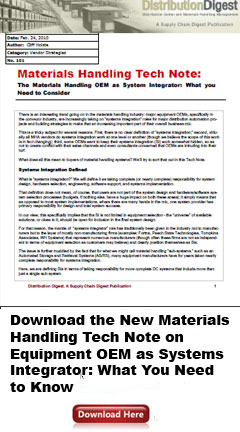OEMs are Increasingly Looking to be Complete SIs
 The materials handling automation manufacturers best positioned to become SIs are the vendors most commonly associated with largeconveyor systems. Why? Because each of these companies (especially with the Intelligrated acquisition of FKI Logistex) brings a wide ranging set of materials handling technologies, and have the size and resources to pursue such a strategy. The materials handling automation manufacturers best positioned to become SIs are the vendors most commonly associated with largeconveyor systems. Why? Because each of these companies (especially with the Intelligrated acquisition of FKI Logistex) brings a wide ranging set of materials handling technologies, and have the size and resources to pursue such a strategy.
In part, this is a desire to get closer to customers. It is also part of the general trend towards vendors of all sorts looking to "add more value" to a system sale.
It is also a reaction to the strategies of several European providers (e.g., SSI-Schaefer, Witron) with a growing US presence, have been using the SI approach in their home market for years, and are having some success pursuing the same strategies in North America.
Finally, the growth of Automated Case Picking (ACP) as a materials handling technology category is also a factor, as no one OEM will any time soon have the whole breadth of ACP technologies within their product portfolios. So, to be able to offer a full solution to custoemrs interested in ACP, they must be able to provide and integrate ACP solutions within a larger total DC project.
No one should expect, however, that a conveyor manufacturer acting as SI is going to use a competitor’s conveyor system or other basic equipment as part of the total system. Nevertheless, if an equipment OEM is going to position itself as a true SI, it absolutely must be willing to look at technologies and equipment that it does not currently manufacture as part of the total system design.
In a sense, there is a larger question of whether you should use an SI of any type to lead your project, but we will leave that subect for another day. In our full Tech Note, we provide a more detail set of recommendations to materials handling users about how to think about this trend and most effectively make the right decision for your company and project.
The real test will be if OEMs can truly take this independent approach with long-term customers with which they have a somewhat “captive” relationship. If you find an OEM that has demonstrated a true SI approach in that scenario, it increases the odds you will be served equally well.
The rise of automated case picking technologies over the next five years will make this question and decision an increasingly important one for MHA users.
We expect an increasing amount of true systems integration work to be performed by manufacturers over the next 2-3 years, but as is often the case – trust, but verify.
What is your take on the potential of equipment manufacturer as sysems integrator? What are the pros and cons? Let us know your thoughts at the Feedback button below.
SCDigest is Twittering!
Follow us now at https://twitter.com/scdigest |